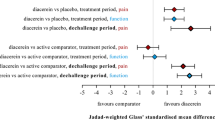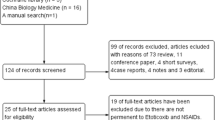Summary
Etodolac (Lodine ®,Ramodar ®,Ultradol ®), an anti-inflammatory, analgesic agent, is the first of a new class of nonsteroidal anti-inflammatory drugs (NSAIDs), the pyranocarboxylic acids. A review of the literature on numerous clinical studies showed that etodolac (200 to 600 mg/day) is effective in the treatment of osteoarthritis and rheumatoid arthritis. Etodolac has also been shown to be very well tolerated. In double-blind studies, there were no significant differences in the incidences of new patient complaints except for indigestion between etodolac-treated groups and placebo-treated groups. Gastrointestinal microbleeding associated with etodolac was comparable to that with placebo and was significantly less than that associated with other commonly used NSAIDs, such as ibuprofen, indomethacin, piroxicam, and naproxen. The results of laboratory tests, including a detailed analysis of hepatic and renal function, have revealed few abnormalities, most of which were clinically unimportant. When administered to healthy subjects, etodolac had no pharmacokinetic interactions with three other drugs that are highly bound to serum protein: warfarin, glyburide, and phenytoin.
Sommario
L'Etodolac, (Lodine ®,Ramodar ®,Ultradol ®) un agente analgesico anti-infiammatorio, è il primo di una nuova classe di farmaci anti-infiammatori non steroidali, gli acidi piranocarbossilici. Un esame della letteratura su numerosi studi clinici ha mostrato che l'etodolac (200–600 mg/g) è efficace nella cura dell'osteoartrite (OA) e dell'artrite reumatoide (AR). L'etodolac ha dimostrato anche di essere ben tollerato. Nell'ambito di studi a doppio cieco non vi sono state differenze significative nell/incidenza di nuove lamentele da parte dei pazienti, fatta eccezione per l'indigestione, tra gruppi trattati con etodolac e gruppi trattati con un placebo. Le microemorragie intestinali collegate all'etodolac erano paragonabili a quelle con la somministrazione di un placebo ed erano significativamente inferiori di quelle associate ad altri farmaci anti-infiammatori non steroidali comunemente usati, quali l'ibuprofene, l'indometacina, il pirossicam e il naprossene. I risultati delle prove di laboratorio, compresa un'analisi dettagliata della funzione renale ed epatica, hanno rivelato poche anormalità, la maggior parte delle quali non importanti dal punto di vista clinico. Se somministrato a soggetti sani l'etodolac non ha avuto interazioni farmacocinetiche con tre altri farmaci che sono altamente legati alla proteina del siero: warfarina, gliburide e fenitoina.
Resumen
Etodolac (Lodine ®,Ramodar ®,Ultradol ®), un agente antiinflamatorio analgésico, es el primero de una nueva clase de fármacos antiinflamatorias no esteroides (FAINE), los ácidos piranocarboxilicos. Una revisión de la literatura sobre numerosos estudios clínicos mostró que etodolac (200–600 mg/día) es efectivo para el tratamiento de la osteoartritis (OA) y de la artritis reumatoidea (AR). Se ha mostrado también, que etodolac es bien tolerado. En estudios doblemente a ciegas, no se produjeron diferencias significativas en las incidencias de molestias en los pacientes nuevos, excepto por la indigestión, entre los grupos tratados con etodolac y los grupos que recibieron placebo. La hemorragia gastrointestinal asociada a etodolac fue similar a la producida con el uso de placebo y fue significativamente inferior a la asociada a otros FAINE comÚnmente utilizados, tales como ibuprofén, indometacina, piroxicam y naproxén. Los resultados de las pruebas de laboratorio, incluyendo un análisis detallado de la función hepática y de la renal, han mostrado pocas anormalidades, careciendo la mayoría de las mismas de importancia clínica. Cuando se administró etodolac a sujetos sanos no se produjeron interacciones farmacocinéticas con otros tres fármacos que se unen extensamente a las proteínas plasmáticas: warfarina, gliburida y fenitoína.
Zusammenfassung
Etodolac (Lodine ®,Ramodar ®,Ultradol ®), ein entzündungshemmendes Analgetikum, ist die erste Substanz einer neuen Klasse nichtsteroidaler entzündungshemmender Antirheumatika (NSAR), der PyrancarbonsÄuren. Den Literaturangaben über zahlreiche klinische Untersuchungen ist zu entnehmen, daΒ Etodolac (200– 600 mg/Tag) zur Behandlung von Osteoarthritis (OA) und rheumatoider Arthritis (RA) therapeutisch wirksam ist. ZusÄtzlich wird Etodolac sehr gut vertragen. AuΒer Verdauungsstörungen wurden in Doppelblindstudien keine signifikanten Unterschiede im Auftreten neuer Patientenbeschwerden zwischen den mit Etodolac behandelten Gruppen und den Placebo Kontrollgruppen festgestellt. Die auf Etodolac zurückzuführenden gastrointestinalen Mikroblutungen waren mit denen in den Placebo-Kontrollen vergleichbar, waren aber erheblich geringfügiger als bei anderen hÄufig verabreichten NSAR z.B. Ibuprofen, Indometacin, Piroxicam und Naproxen. Labordaten, einschlieΒlich ausführlicher Analysen der Leber- und Nierenfunktionen, ergaben nur wenige von der Norm abweichende Werte, von denen die meisten klinisch unbedeutend waren. In gesunden Probanden waren pharmakokinetische Interaktionen zwischen Etodolac und drei anderen, stark an Serumprotein gebundenen Therapeutika, nÄmlich Warfarin, Glyburid und Phenytoin, nicht nachweisbar.
Résumé
L'étodolac (Lodine ®,Ramodar ®,Ultradol ®), produit anti-inflammatoire et analgésique, est le premier médicament d'une nouvelle classe d'anti-inflammatoires non stéroÏdiens (AINS): les dérivés de l'acide pyranocarboxylique. Une revue de nombreuses études cliniques publiées dans la littérature a souligné l'efficacité de l'étodolac (à raison de 200–600 mg/jour) dans le traitement de l'arthrose et de la polyarthrite rhumatoÏde (PR). D'autre part, l'étodolac a fait preuve d'une très bonne tolérance. Dans les études à double insu, aucune différence significative n'a été observée en ce qui concerne l'incidence de nouveau symtÔmes dont les malades s'étaient plaints, exception faite de l'indigestion, entre les groupes traités par étodolac et les groupes traités par placebo. Au niveau de l'appareil digestif, les microrragies associées à l'étodolac étaient comparables à celles qui se sont produites sous placebo et elles étaient significativement moins importantes que celles qui étaient associées à d'autres AINS employés couramment, tels que l'ibuprofène, l'indométacine, le piroxicam, et le naproxène. Les résultats d'examens biologiques, y compris l'analyse détaillée des explorations fonctionnelles hépatique et rénale, ont fait ressortir peu d'anomalies et pour la plupart sans importance clinique. A la suite de l'administration de l'étodolac à des sujets sains, aucune interaction pharmacocinétique n'a été observée entre celui-ci et trois autres médicaments qui présentent un pourcentage élevé de liaison aux protéines sériques: la warfarine, le glibenclamide, et la phénytoÏne.
Similar content being viewed by others
References
Ferdinandi, E.S., Sehgal, S.N., Demerson, C.A., et al. Disposition and biotransformation of14C-etodolac in man. Xenobiotica 1986, 16, 153–166.
Sanda, M., Collins, S.H., Mahady, J., Huth, J., Kranz, K. Three-month multicenter study of etodolac (Ultradol®) in patients with osteoarthritis of the hip. Curr Ther Res 1983, 33, 782–792.
Gengos, D., Sanda, M. Long-term effectiveness of etodolac (Lodine®, Ramodar®, Ultradol®) in patients with osteoarthritis. (Abstract) Clin Exp Rheumatol 1987, 5/S-2, 203.
Andelman, S.Y. Etodolac, aspirin and placebo in patients with degenerative joint disease: a twelveweek study. Clin Ther 1983, 5, 651–611.
Koonce, M.L., Levy, M.E. Long-term study of etodolac in the treatment of patients with osteoarthritis. Today's Ther Trends 1984, 2, 1–7.
Vetter, G., Placchi, M., Joubert, L. Comparative efficacy of etodolac and placebo in rheumatoid arthritic patients. Int J Clin Pharmacol Ther Toxicol 1982, 20, 240–245.
Jacob, G., Messina, M., Kennedy, J., Epstein, C., Sanda, M., Mullane, J. Minimum effective dose of etodolac for the treatment of rheumatoid arthritis. J Clin Pharmacol 1986, 26, 195–202.
Gordon, G.V., Polsky, B.G. Three-month trial of etodolac (UltradolR) compared with aspirin and placebo in patients with rheumatoid arthritis. Curr Ther Res 1983, 33, 89–99.
Edwards, W. Etodolac, aspirin and placebo in patients with rheumatoid arthritis: a 12-week study. Clin Ther 1983, 5, 495–503.
Del Toro, R.A., Concepción, R. Twelve-week study of etodolac, aspirin, and placebo in patients with rheumatoid arthritis. Clin Ther 1983, 5, 437–444.
Jacob, G.B., Hart, K.K., Mullane, J.F., Lutins, S., Lee T.Y. Placebo-controlled study of etodolac and aspirin in the treatment of rheumatoid arthritis. Curr Ther Res 1983, 33, 703–713.
Jacob, G., Sanda, M., Mullane, J., Kennedy, J., Barbetti, M., Suleski, P. Long-term evaluation of the efficacy and safety of etodolac in the treatment of rheumatoid arthritis. Adv Ther 1985, 2, 82–95.
Jacob, G., Messina, M., Caperton, E., Gordon, R., Harris, G., Sack, B., Vreede, P., Weitzman, R. Safety and efficacy of etodolac, once or twice a day, in the treatment of active rheumatoid arthritis. Curr Ther Res 1985, 37, 1124–1129.
Waltham-Weeks, C.D. Etodolac versus naproxen in rheumatoid arthritis: a double-blind crossover study. Curr Med Res Opin 1987, 10, 540–547.
Arnold, J.D., Mullane, J.F., Hayden, D.M., March, L., Hart, K., Perdomo, C.A., Fencik, M., Bergen, A.E. Etodolac, aspirin and gastrointestinal microbleeding. Clin Pharmacol Ther 1984, 35, 716–721.
Jallad, N.S., Sanda, M., Salom, I.L., Perdomo, C.S., Garg, D.C., Mullane, J.F., Weidler, D.J. Gastrointestinal blood loss in arthritic patients receiving chronic dosing with etodolac and piroxicam. Am J Med Sci 1986, 292, 272–276.
Salom, I.L., Jacob, G., Jallad, N., Perdomo, C.A., Mullane, J.F., Weidler, D. Gastrointestinal microbleeding associated with the use of etodolac, ibuprofen, indomethacin, and naproxen in normal males. J Clin Pharmacol 1984, 24, 240–246.
Arnold, J.D., Salom, I.L., Berger, A.E., Meinders, J.D., Jacob, G., Hayden, D., Mullane, J.F. Comparison of gastrointestinal microbleeding associated with use of etodolac, ibuprofen, indomethacin, and naproxen in normal subjects. Curr Ther Res 1985, 37, 730–738.
Bianchi Porro, G., Montrone, F., Caruso, I., Ardizzone, S., Petrillo, M., Sarzi Puttini, P.C. Etodolac vs. naproxen: clinical and endoscopic double-blind study. (Abstract) Clin Exp Rheumatol 1987, 5/S-2, 201.
Sanda, M., Jacob, G., Shand, D.B. A safety profile of etodolac in arthritis: clinical experience based on 600 patient-years. Today's Ther Trends 1985, 3, 1–15.
Scatina, J., Hicks, D., Kraml, M., Weidler, D., Garg, D., Sanda, M. Etodolac kinetics in the elderly. Clin Pharmacol Ther 1986, 39, 550–553.
O'Reilly, R.A. Anticoagulant, antithrombiotic and thrombolytic drugs: In: Goodman & Gilman's The Pharmacological Basis of Therapeutics, 7th ed., Editors: Gilman, A.G., Goodman, L.S., Rall, T.W., Murad, F. New York, MacMillan, 1985.
Fowler, P.D. Diclofenac sodium (Voltarol): Drug interactions and special studies. Rheumatol Rehabil 1979, Suppl 2, 60–68.
Knusel, O., Huber, J. Der Einfluss nicht-steroidaler Antirheumatika auf den Kohlehydratstoffwechsel. Akt Rheumatol 1983, 8, 90–95.
Melander, A., Wahlin-Boll, E. Interaction of glipizide and indoprofen. Eur J Rheumatol Inflamm 1981, 4, 22–25.
Pedrazzi, F., Bommartini, F. A study of the possible interaction of indoprofen with hypoglycemic sulfonylureas in diabetic patients. Eur J Rheumatol Inflamm 1981, 4, 26–31.
Voigt, U., Klassen, E. Zur Pruefung von ketoprofen auf Interaktionen mit oralen Antidiabetika. Eine doppelblinde, kontrollierte klinische Cross-over-Studie. Med Welt 1982, 1592–1593.
Perrucca, E. Pharmacokinetic interactions with antiepileptic drugs. Clin Pharmacokinet 1982, 7, 57–84.
Author information
Authors and Affiliations
Rights and permissions
About this article
Cite this article
Zvaifler, N. A review of the antiarthritic efficacy and safety of etodolac. Clin Rheumatol 8 (Suppl 1), 43–53 (1989). https://doi.org/10.1007/BF02214109
Issue Date:
DOI: https://doi.org/10.1007/BF02214109




